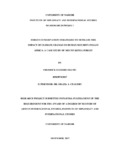| dc.description.abstract | Forests, when sustainably managed, can have a central role in climate change mitigation and adaptation. Climate change continues to pose a challenge to nations and the world at large, with the resultant increase in drought, unpredictable rainfall patterns, and natural disasters such as floods and coastal storms will be disproportionately suffered by the vulnerable groups and the marginalized. The effects of climate change are complex requiring global, regional and national interventions. The general objective of the study is to establish forest conservation strategies to mitigate the impact of climate change and on human security in East Africa, using a case study of Mount Kenya forest. This study aims to add insightful writing to other scholarly publications on the difficulties and opportunities of forest protection in Kenya. Furthermore, this study expects to include any new information on issues to do with climate change in East Africa. The study will apply neo-realism theory. Realists trust that force is the money of universal legislative issues. Extraordinary forces, the principle on-screen characters in the realists' record, give careful consideration on how much financial and military force they have with respect to each other. The study applied case study as a research design to establish the climate change and human security issues using a case study of forest conservation. Case studies provide rich raw material for advancing theoretical ideas. Documents, observations, and interviews can all be sources of information for a case study. The study used interview methodology that is guided on the discussion themes and which was enhanced by taking notes. The study population was be respondents from, the National Environmental Management Authority (NEMA), the Kenya Wildlife Service (KWS), the Kenya Forest Service (KFS), the police office, the fisheries office, the Kenya Plant Health Inspectorate Service (KEPHIS), the Lusaka Agreement Taskforce (LATF), the United Nations (UN), nongovernmental organizations (NGO) and the communities, (community forest associations in the adjacent sub-counties) in the zones with high predominance of natural forest. Data analysis was done by use of descriptive statistics and document analysis. The researcher used qualitative data collected to make general statements on how categories or themes of data are related. The study outcomes have been presented in form of narrative, pie charts, bar graphs and frequency table. | en_US |



